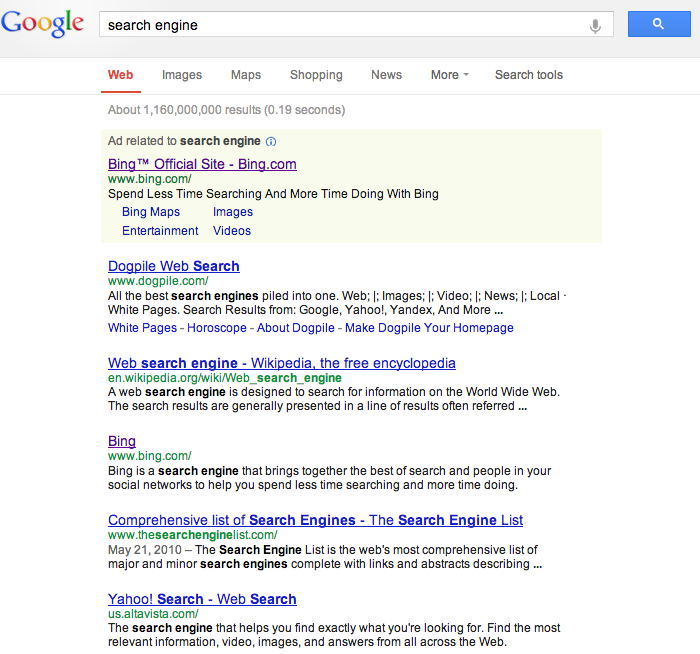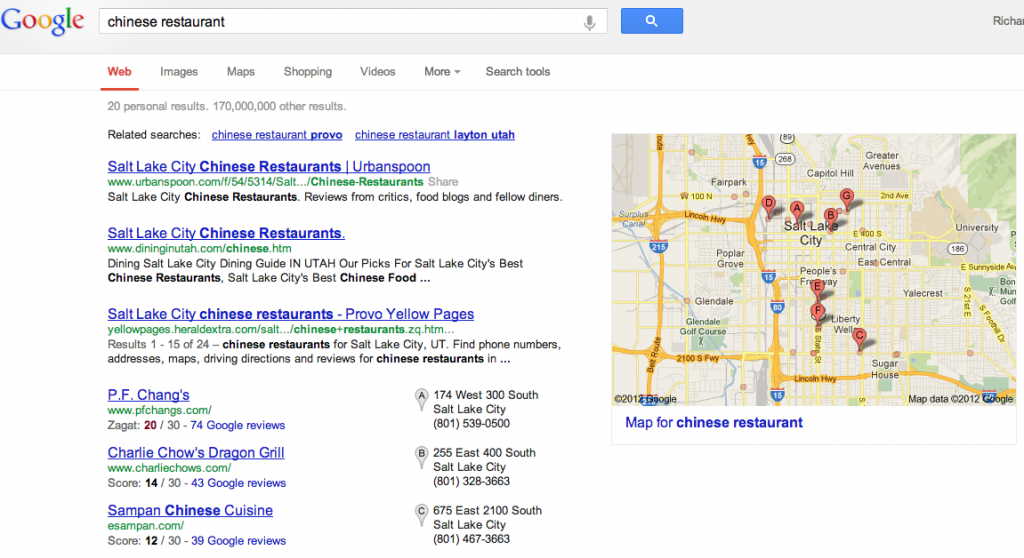The Evolution of Search Engine Results
Companies have been using search engine optimization to market themselves since before 2000. Google’s emergence in the late 1990’s as the dominant search engine, with its new formula for making the Internet “universally accessible and useful,” created a market for inbound marketing as people and companies learned how to optimize their web pages so that they’d rank near the top of Google searches to capitalize on the hundreds of millions of searches done on Google each month.
In the beginning, Google search results pages were almost strictly filled with references to web pages. Drawing in traffic to your company’s web presence involved:
- creating web pages that targeted the search terms you wanted to own
- getting links to those pages to give them ranking authority

A Google search for ‘search engine’ shows only web page results.
Google and its competitors have since become much better at trying to understand their audiences and presenting to them the information they want as efficiently as possible. That increasing focus on the intent of a search gave birth to local search marketing.
To understand how to attract customers through local search optimization, you need to understand how Google handles searches in this new age of customized search results.
Breaking Down A Google Search
When a person does a Google search, there are some filters through which Google evaluates and processes the search. Google has access to huge amounts of data from lots of sources that help it to determine what a person’s intentions are. They consider the semantics of the search phrases used, the person’s geographical location, their search history, and other indicators that help them put together pieces of a puzzle so they can retrieve the most relevant results from the web. In the past those results were typically just links to web pages and snippets of information about those links. As the search engines have evolved, they’ve gotten better at providing information to users that include images, shopping results, videos, and [drum roll…] results that include local businesses. For instance, if someone searches for a phrase like dentist or accountant or Chinese restaurant, the some other term that has local intent (meaning that the user is searching for a local company), Google will normally display the names, addresses, and phone numbers of businesses that it thinks are the closest matches to what the searcher is looking for. Google also includes a map that shows those locations so that the searcher can find his way to the one he prefers. The example below is from a search done for Chinese Restaurant in the Salt Lake City, Utah area. You can see that PF Changs is most likely to get some customers from this scenario, since it ranks at the top of the local search results.

When a person searches for “chinese restaurant” in the Salt Lake City area, Google has determined that PF Changs is the most relevant.
What About My Business?
Hopefully you can see how valuable it would be have your company listed at the top of Google searches in scenarios like the one above. Here are some of the factors that Google, Bing, and Yahoo use to determine who to show at the top of their maps listings.
Maps
The essence of a local business is its geographic location. Google makes use of maps, both its own and ones published by other mapping services, to understand what businesses exist where.
Web Pages and Links
Google ranks businesses that it trusts at the top of local searches. Much of that trust is created with a website that has good content and lots of links pointing to its pages. This includes links from social media sites like Twitter, Facebook, YouTube, and Google Plus.
Citations
When Google crawls web pages and directories throughout the web and finds references to your company’s name, address, and phone number, it’s as if your business has references (think of it like a job interview) that somewhat vouch for your company and its products and services.
User Reviews
Google tries to ascertain whether there are customers who are talking about your business online and gauges what they’re saying about you, including ratings that can be posted online by customers.
User Interaction
Google records user interaction with the business listings it presents. If someone searches for a product or service that you provide, and Google shows your listing several times, but nobody interacts with it (clicking on the link to your website, asking for driving directions, etc.), Google can figure out that your business is not as relevant as when people do interact with your listing.
To summarize these local search ranking signals, in order for Google to rank your business for local phrases it believes are related to your business, you have to establish trust and authority through references and interactions with your listing on maps, web pages (your own web site and others), and with positive user interaction.
